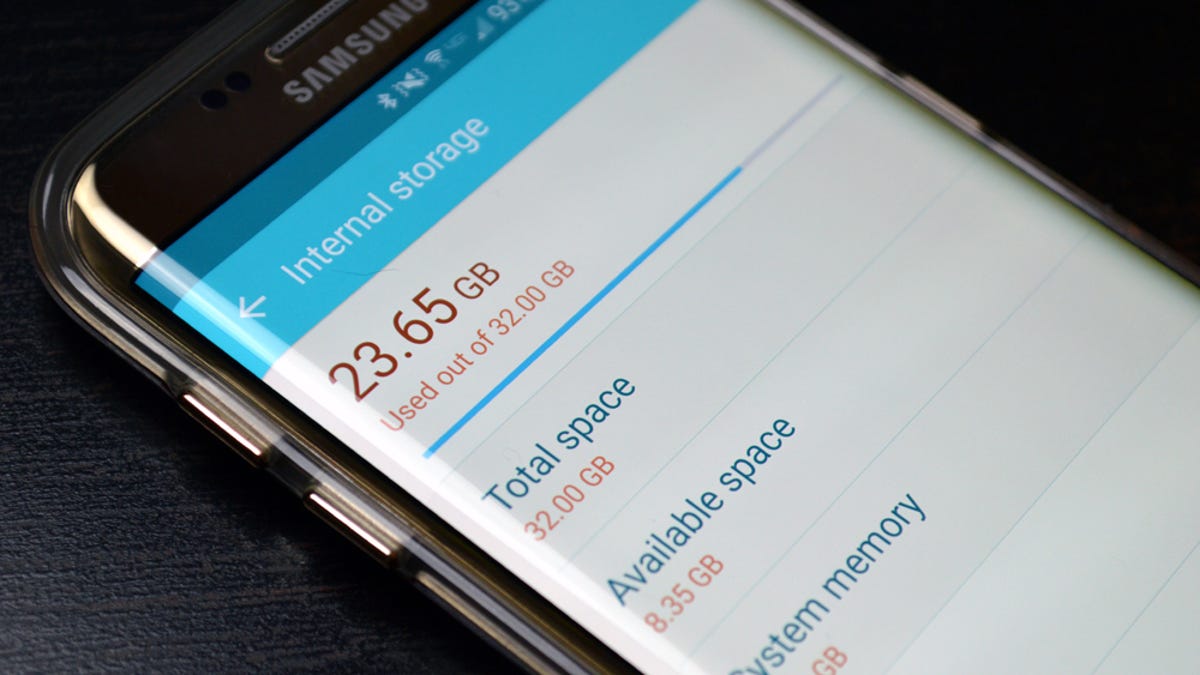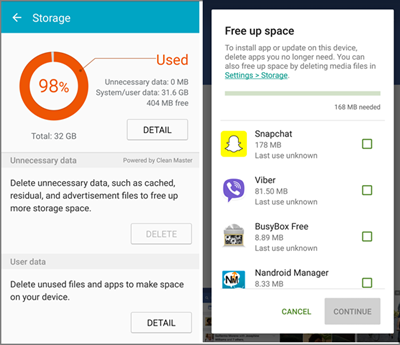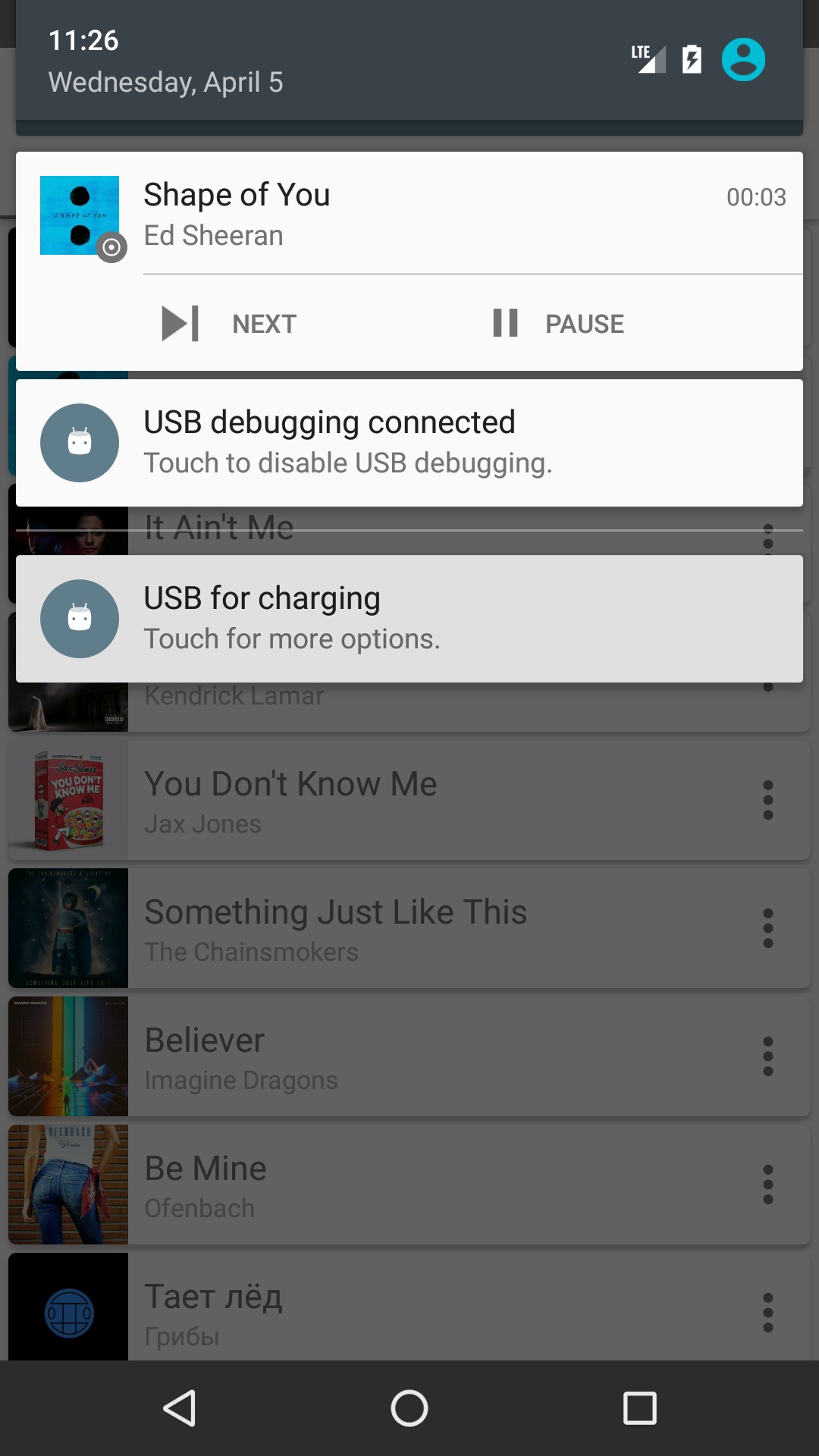6 Ways to Clear Data on Android Devices 1. Have automatically backup of data: Always have an automatic backup for your Android device so that you can delete you clicked pictures and videos and free up space from your Android Device. Backup has both benefits to clear your storage and also restore when you lost your phone. Click the button Storage and Clear Cache; If you're running Android 6.0 Marshmallow on your device, like my Huawei Android 6.0, simply click on Files and then Clean up. If you’re using Android 7, you can clear all app cache data at once in Settings Storage Cached data. If the phone is having performance issues — or if an app is glitching — you might even hit. Scroll down and tap Storage. You should see the amount of space utilized by the app cache under “Cache” or “Cached data.” You may have to select a storage location first. Choose Internal Storage or your SD card, if prompted. If you tap on an individual app in Settings Apps/Apps and Notifications, then you should see the option to Clear Data. If you’re using Android 6.0 Marshmallow or later, you’ll have to tap on.
- How To Free Up Storage On Android
- How To Clear Up Internal Storage On Android
- How To Clear Up Other Storage On Android
- How To Clear Up Storage On Android Phone
| Why Storage Disappears So Fast? |
| How to Check Storage Condition on Android? |
| How to Free up Space on Android Phones? |
Android devices are fantastic for their ease of use and customization options, however eventually all your precious space is filled. We will look at ways to effectively free up Android phone storage. This problem is particularly acute for phones more than a year old; performance is impacted if the user does not release Android phone storage. We will look at ways to effectively free up Android phone storage.
/cdn.vox-cdn.com/uploads/chorus_asset/file/18943545/save_photos_1__1_.png)
Why Storage Disappears So Fast?
The storage is not a live creature that can run away itself, so check whether you match any of the following conditions:
Lots of pre-installed apps: some manufacturers are notorious for bloatware (e.g. Asus and Samsung), so their pre-installed apps, along with system-level Android OS, both take their toll immediately – literally right out of the box.

Install apps in built-in phone space: sometimes you didn't notice that the app installation location was set as the built-in phone space not the SD card. The limited phone space is easier to be filled with apps.
How To Free Up Storage On Android
Limited storage capacity: even though you can address limited internal storage (e.g. 16GB) with external storage, the low storage warning will also appear with the microSD card if you are a heavy multimedia user.
Phone trash accumulates: temp files, duplicates files, cache, and other unnecessary files are produced all the time. This is a natural by-product of apps, system files, and the OS itself. Over time, this is cumulative and can have a major impact on phone responsiveness if you do not clean the junk regularly.
How to Check Storage Condition on Android?
Before to start a storage release, we should figure out what takes the most space on our phone for solving this problem effectively.
1. Go to your phone main menu, and find out the 'File' icon inside to tap in. Clearly you will see different options there - Category, Storage, and Cloud. Simply tap the 'Storage', your phone space using condition is clearly presented here.
Here you are allowed to view total space and available space on both phone and SD card. Also, simply tap the two locations individually, all the folders inside will show up for your checking.
2. Enter your Android 'Settings' to look for the 'Power and Storage' option. Tap to access it, the 'Storage Space' is there showing the ROM and SD card available space. Tap the button, a circle graph presents you the space that each type of data takes up, for both phone and SD card as well.
How to Free up Space on Android Phones?
There are four ways to reclaim your storage:

1. Clean out junk items regularly
Always use a good mobile management app to clean/remove your phone junk. Examples of junk includes outdated cache, installation packages (APK), uninstalled app remnants, and app cache. This is an effective way to release Android phone space.
Note: Most Android phones already feature pre-installed management app, e.g. Huawei, Xiaomi, OPPO, Meizu, etc. If your phone doesn't already have one, simply download one from the Play Store (for example, Tencent WeSecure)
For our example, we will use the OPPO FIND 7 built-in app.
• Launch your app of choice.
• Tap 'Scan' to commence scanning – this will search for viruses, potential dangers, and junk items using up space.
• Once scanning finishes, the app will automatically delete the junk.
• Or enter the 'File' menu to use the 'Clearup' feature to clean the useless cache.
• Tap 'End all' to wipe them out.
2. Expand external storage (if available)
Add a large capacity Micro SD card, the card storage better starts at 32GB.
3. Files transfer
If you don't want spend money on a SD card, you can do like these to release plenty of space:

• Transfer large files like videos, images, and music to your computer.
• Alternatively, upload the big files to the cloud like Google Photos, Dropbox, Microsoft OneDrive, Flickr, etc. You can download the apps to backup your files and delete the copies on your phone or just upload on the website.
4. Uninstall rarely used apps
Fast uninstall:
• Long press the app icon until a small 'x' appears near the icon.
• Tap the 'x' to commence uninstalling.
• Tap 'Delete' to confirm app deletion.
On some Android phones, long press the app icon and drag it to the trashcan at the screen top instead.
Direct uninstall:
• Enter the phone 'Settings'.
• Enter 'Application management'.
• Choose 'Installed' category.
• Select the apps you rarely use and tap 'Uninstall'.
• Tap 'Uninstall' to confirm the selection.
Note: Following app deletion, use the phone management app to clean any residual files from the uninstallation process to free more space.
5. App transfer
How To Clear Up Internal Storage On Android
Transfer pre-installed to the external SD card. (Only available to Android devices with external storage)
• Enter the phone 'Settings'.
• Enter 'Application management'.
• Choose the 'Installed' or 'All' category including the pre-installed apps.
• Select all the apps individually and tap 'Move to user space' to transfer to the SD card.
• Use the phone management app to clean the trash.
If your Android device is more than 3 years old, we would strongly suggest changing to a more up-to-date device with more advanced features and storage. You've though about it as well? Then both OnePlus 3T and UMI Super are pretty good choices that not only sport large storage but also fast process speed - 6GB RAM+128GB storage and 4GB+32GB (256GB expansion). Therefore, you won't be bothered by the storage limitation again. Want more affordable premium Android phone choices? You can have a look here on Gearbest.
How To Clear Up Other Storage On Android
Before I forget, there is currently a top phone brand sale at that with up to 68% off for a limited time only. Have a look before it's too late! Hope this article does work for you :)
| You may also want to read: |
| Android Masterclass | Easy steps to fix frozen or dead Android phones |
| 7 sure-fire ways to speed up your Android smartphone |
| Android / iOS Guide | 3 easy ways to save your mobile data |
- Android 12 will automatically hibernate unused apps to free up storage space.
- The app hibernation feature will remove temporary files and stop notifications from apps that haven’t been used for months.
The first traces of a new app hibernation feature on Android 12 appeared back in January and were spotted as part of the code changes submitted to the Android Open Source Project (AOSP). Now, folks over at XDA Developers have managed to make the feature work on a leaked Android 12 build they recently obtained.
The publication confirms that the code for app hibernation is present in the build which is apparently newer than Developer Preview 2.
Google seems to be building upon the existing unused apps section in Android 11 with the new app hibernation feature in Android 12. In addition to automatically revoking permissions for unused apps, Android 12 will also reportedly clear up temporary files to free up storage on your phone.
XDA activated the new unused apps section on the “App Info” setting of every app. It contains a toggle for removing permissions and freeing up space. In comparison, Android 11’s toggle to remove permissions can be found under the “App permissions” section of the “App Info” page.
How To Clear Up Storage On Android Phone
After the publication managed to hibernate a few apps manually, the unused apps setting showed apps that haven’t been opened in a few months. The description of the unused apps states that Android 12 will remove permissions from these apps, stop notifications to save battery, and remove temporary files to free up space.
As per previously spotted code changes, the removed files will consist of an app’s cache. This might not make a huge difference in terms of freed up storage on devices that have plenty of it, but users with entry-level or low-end phones might notice the benefits.
XDA is unsure if the app hibernation feature will show up on the next Android 12 developer preview. However, it seems more than likely to be a part of the final build.
